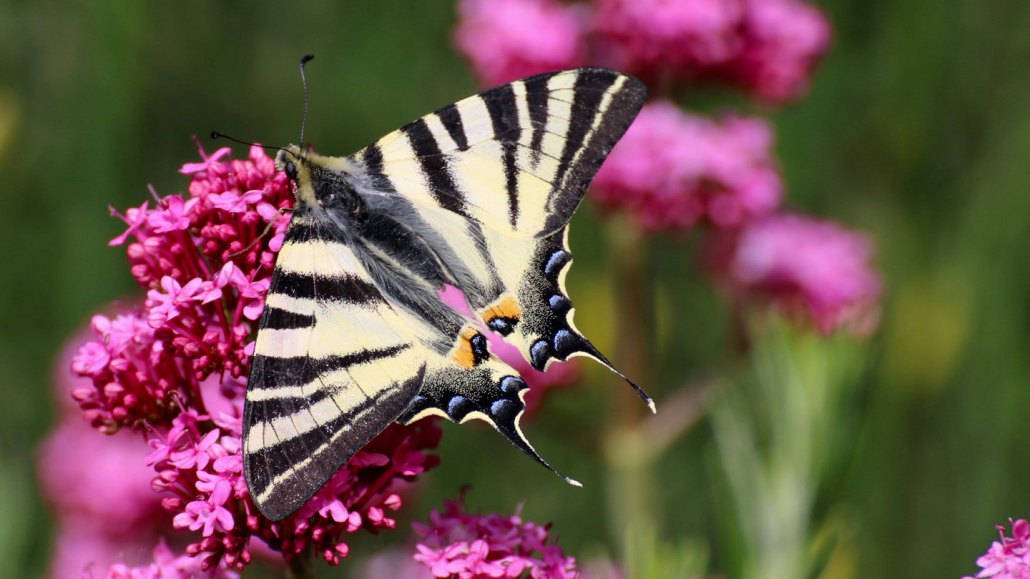Butterfly ‘tails’ might be part of an escape tactic
These eye-catching wing extensions break off easily in the beaks of attacking birds

The tail-like extensions on the sail swallowtail’s wings may help divert attacking birds away from the butterfly’s head and abdomen.
Caroline Gauvin/Moment/Getty Images Plus
Share this:
- Share via email (Opens in new window) Email
- Click to share on Facebook (Opens in new window) Facebook
- Click to share on X (Opens in new window) X
- Click to share on Pinterest (Opens in new window) Pinterest
- Click to share on Reddit (Opens in new window) Reddit
- Share to Google Classroom (Opens in new window) Google Classroom
- Click to print (Opens in new window) Print
By Jake Buehler
Tail-like extensions on some butterfly wings may be more than just stylish. These break-away parts may help them survive attacks by hungry predators, new data suggest.
These eye-catching “tails” may have evolved as a decoy to keep hungry birds from grabbing a butterfly’s head or abdomen, scientists say. This might also help explain why such wing tails have evolved multiple times in different species of moths and butterflies.
“A lot of these butterflies display tails,” says evolutionary biologist Ariane Chotard. “And we don’t really know why.” Chotard studies the wings of swallowtail butterflies at the National Museum of Natural History in Paris.
Birds are known to attack eyespots or head-shaped patterns on butterfly wings. Chotard and her colleagues wondered if birds might also target wing tails.
To find out, they collected sail swallowtail butterflies near Ariege, France. The insects’ formal name is Iphiclides podalirius (IF-ih-KLIH-deez Poh-dul-IR-ee-us). These butterflies are found throughout Europe and Asia. They get their common name from the two black tails extending from their wings. (They look a lot like the forked tails of the family of birds called swallows.) On the wings just above the butterfly’s tails are splotches of blue and orange. These vivid colors stand in sharp contrast to the yellow stripes covering the rest of the wings.
Among the 138 swallowtails collected, 65 — not quite half of them — had at least one damaged tail. When the researchers looked at all 130 of the wings in this group (there are two wings per butterfly), they found that more than eight in every 10 of the wings had damaged “tails.” This suggests predators indeed may target the eye-catching structures.
The birds weigh in
The team decided to test that idea. They captured several dozen songbirds called great tits. Then they introduced butterfly mimics to the caged birds. The biologists made the fake insects by gluing real swallowtail wings to a cardboard body. Videos recorded how the birds responded.
And respond they did. They attacked the fake insects.
The researchers also measured the force needed to tear off different sections of a swallowtail’s wing. The tail’s vein was the most fragile part. So it’s not surprising that it could break off most easily in a bird’s beak.
Nearly three in every four of their beak strikes — 43 out of 59 — focused on lower parts of the wings. And nearly four in every 10 strikes hit both a tail and the orange and blue colored areas on the wing at the same time. That was more than any other body area on these insect decoys.
Chotard’s team published its findings May 25 in the Proceedings of the Royal Society B.
Their data suggest those tails distract birds away from the prey’s most vulnerable body parts. And because the tails tear off easily, attacked butterflies often can escape and fly away. Something similar is seen in some lizards. They, too, can have break-away tails that allow them to escape hungry predators.
It’s unclear if there’s a downside to a butterfly losing two tails versus one, Chotard says. “You survived. You escaped from a predator, but maybe there’s a trade-off.” For instance, she notes, it’s possible that losing those tails might slow their flight.
The tails of some moths can interfere with the echolocation tactics of hungry bats. “Now we have evidence that butterfly tails provide a similar benefit against visual predators,” says Juliette Rubin. She’s an evolutionary biologist who works at the University of Florida in Gainesville.
Rubin says the next step by Chotard’s group might be studying the survival benefits of butterfly tails in real-life. It would be helpful, she says, “to see how live swallowtail butterflies — both with and without tails — fare against bird predators.”







